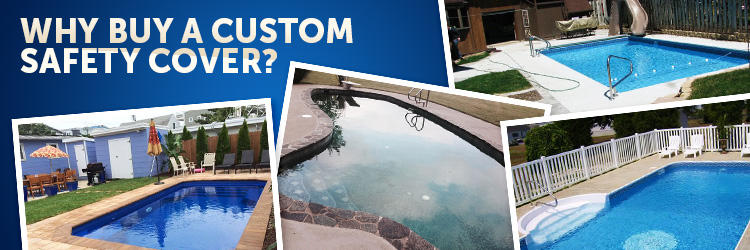
Pool Cover
Troubleshooting
Resources for fixing your cover problems.

Tip: Using and maintaining a pool cover can significantly reduce cleaning time, help retain heat, and lower chemical usage in your pool. Regularly inspect your cover for tears or wear, and remove any debris that accumulates on top. For winter covers, secure them tightly to keep out leaves and dirt, and ensure safety covers are properly anchored. A clean, well-maintained pool cover not only protects your pool during the off-season but also extends the life of your equipment and reduces maintenance costs.
Common Cover Problems
Click on a symptom that you are experiencing…
Cover is Sagging or Accumulating Water
Problem:
If your pool cover is sagging or collecting water, it may indicate insufficient tension, poor drainage, or improper installation. Allowing water to pool on the cover can strain the material and reduce its lifespan, so addressing the issue promptly can help protect your cover and pool.
Action Items:
- Tighten cover straps: Check that all straps are properly tightened and secure to maintain even tension across the cover, especially after heavy winds or rain.
- Use a cover pump: Placing a small, submersible pump on the cover can help to quickly remove accumulated water after rainfall, preventing sagging and wear.
- Add a support structure: Consider adding an air pillow underneath the cover to create a peak. This can help water and debris to roll off instead of collecting in the center.
- Inspect anchor points: Ensure all anchor points and connections are correctly installed and holding the cover in place. Repair or replace damaged anchors as needed.
Cover is Difficult to Remove or Install
Problem:
If your pool cover is challenging to remove or install, it could be due to issues with the cover’s fit, material weight, or lack of helpful tools. Ensuring the cover is easy to handle makes regular pool maintenance more manageable and reduces strain on the cover itself.
Action Items:
- Check cover dimensions: Verify that the cover is the correct size and shape for your pool. An ill-fitting cover can be cumbersome to handle and may require adjustment or replacement.
- Use a cover reel: Installing a cover reel for larger pool covers can make rolling and unrolling much easier, especially for heavy or solar covers.
Cover is Fading or Becoming Brittle
Problem:
If your pool cover is fading or becoming brittle, it’s likely due to prolonged sun exposure, chemical damage, or general wear and tear. This can reduce the cover’s effectiveness and lifespan, making it more prone to tears and other damage.
Action Items:
- Use a UV-protective cover: Opt for a cover designed with UV protection, which can better resist sun damage and fading over time.
- Limit chemical exposure: Avoid placing the cover on the pool immediately after chemical treatments. Give the chemicals time to disperse to reduce potential damage to the cover.
- Apply a cover conditioner: Regularly applying a cover conditioner or protectant can help maintain flexibility and reduce brittleness, especially in high-sun areas.
- Store properly when not in use: During off-season storage, keep the cover in a shaded, dry area, preferably rolled or folded as directed by the manufacturer to prevent unnecessary wear.










